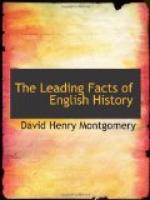In all large towns the merchants had formed associations for mutual protection and the advancement of trade, called merchant guilds. Artisans now instituted similar societies, under the name of craft guilds. For a long time the merchant guilds endeavored to shut out the craft guilds,—the men, as they said, “with dirty hands and blue nails,”—from having any part in the government of the towns. But eventually the latter got their full share, and in some cases, as in London, became the more influential party of the two. There they still survive under the name of the “City Companies.”
275. The Wool Trade.
Under Edward III a flourishing trade in wool grew up between England and Flanders. The manufacture of fine woolen goods was also greatly extended in England. All commerce at this period was limited to certain market towns called “staples.”
To these places produce and all other goods for export had to be carried in order that the government might collect duty on them before they were sent out of the country. If an Englishman carried goods abroad and sold them in the open market without first paying a tax to the Crown, he was liable to the punishment of death. Imports also paid duties.
276. The Great Strike.
The scarcity of laborers caused by the ravages of the Black Death caused a general strike for higher wages on the part of free workingmen, and also induced thousands of villeins to run away from their masters, in order to get work on their own account. The general uprising which a heavy poll tax caused among the villeins (S150), or farm laborers, and other workingmen, though suppressed at the time, led to the ultimate emancipation of the villeins by a gradual process extending through many generations.
VI. Mode of Life, Manners, and Customs
277. Dress; Furniture.
During most of this period great luxury in dress prevailed among the rich and noble. Silks, velvets, scarlet cloth, and cloth of gold were worn by both men and women. At one time the lords and gallants at court wore shoes with points curled up like rams’ horns and fastened to the knee with silver chains.
Attempts were made by the government to abolish this and other ridiculous fashions, and also to regulate the cost of dress according to the rank and means of the wearer; but the effort met with small success. Even the rich at this time had but little furniture in their houses, and chairs were almost unknown. The floors of houses were strewn with rushes, which, as they were rarely changed, became horribly filthy, and were a prolific cause of sickness.
278. The Streets; Amusements; Profanity.
The streets of London and other cities were rarely more than twelve or fifteen feet wide. They were neither paved nor lighted. Pools of stagnant water and heaps of refuse abounded. There was no sewage. The only scavengers were the crows. The houses were of timber and plaster, with projecting stories, and destructive fires were common. The chief amusements were hunting and hawking, contests at archery, and tournaments. Plays were acted by amateur companies on stages on wheels, which could be moved from street to street.




